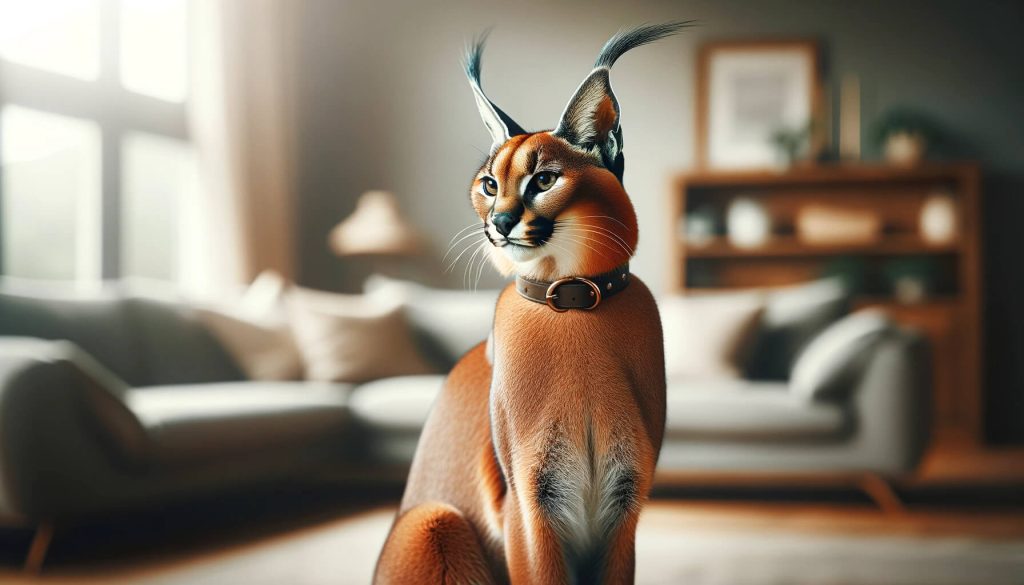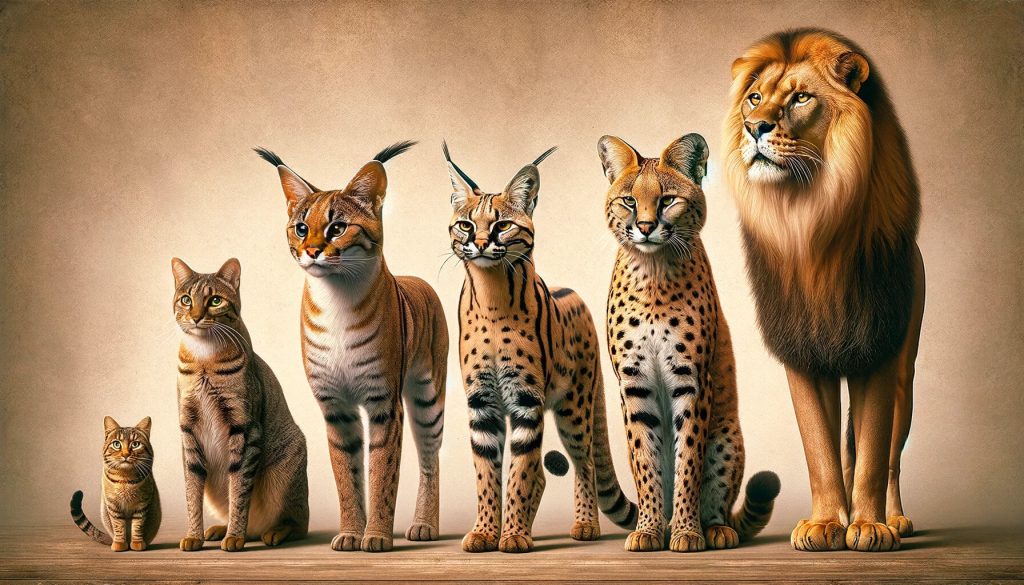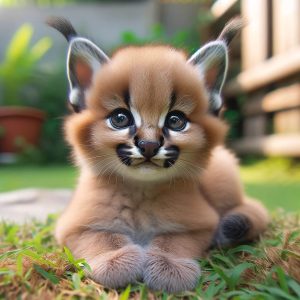
| Caracal Profile | |
|---|---|
| Scientific Name | Caracal caracal |
| Native Regions | Africa, the Middle East, Central Asia, India |
| Size | Medium-sized feline |
| Weight | 12 to 18 kg (26 to 40 lbs) |
| Height at Shoulder | 40 to 50 cm (16 to 20 inches) |
| Key Features | Long, tufted ears; sleek, tawny coat; muscular build |
| Notable Abilities | Leaping up to 3 meters (10 feet) in the air |
| Characteristics | Athletic, elusive, captivating |
What is a Caracal?
The Caracal, known scientifically as Caracal caracal, is a strikingly elegant wild cat native to various regions, including Africa, the Middle East, Central Asia, and India. This medium-sized feline is renowned for its remarkable athleticism and distinctive physical features: notably, its long, tufted ears, sleek, tawny coat, and muscular build. Despite its elusive nature, the caracal has captivated human interest, leading some to consider it as a pet. But what does it truly entail to have a caracal cat in your home?
Quick Overview
Caracals, often referred to as ‘caracal cats’, are a unique species within the larger cat family. They weigh between 12 to 18 kilograms (26 to 40 pounds) and can reach up to 40 to 50 centimeters (16 to 20 inches) in height at the shoulder. Known for their agility, caracals are capable of leaping up to three meters (10 feet) in the air to catch birds in flight. This agility, combined with their secretive nature, has made them both fascinating and somewhat mysterious.
Is Caracal Part of the Cat Family?
Caracals are a part of the Felidae family, which encompasses all types of cats, from the domesticated house cat to the majestic lions of Africa. However, caracals are part of a smaller subset within this family, known as the Felinae, which includes other small to medium-sized cats like lynxes. Their closest relatives are the African golden cat and the serval. Understanding their place in the feline hierarchy is crucial for appreciating their unique nature and needs.
| Domestic House Cat (Felis catus): The smallest in this list, domestic cats typically weigh between 3.6 to 4.5 kg (8 to 10 lbs) and measure about 23 to 25 cm (9 to 10 inches) in height at the shoulder. |
| African Golden Cat (Caracal aurata): Slightly larger than the average domestic cat, African golden cats weigh between 5.5 to 16 kg (12 to 35 lbs) and stand around 40 to 50 cm (16 to 20 inches) at the shoulder. |
| Serval (Leptailurus serval): Servals are medium-sized cats, weighing between 9 to 18 kg (20 to 40 lbs). They stand about 54 to 62 cm (21 to 24 inches) at the shoulder. |
| Caracal (Caracal caracal): Caracals are similar in size to servals, weighing between 12 to 18 kg (26 to 40 lbs), but they are slightly taller, standing at 40 to 50 cm (16 to 20 inches) at the shoulder. |
| Lynx (Genus Lynx): There are several species of lynx, with varying sizes. For example, the Eurasian lynx can weigh between 18 to 30 kg (40 to 66 lbs) and stand around 60 to 75 cm (24 to 30 inches) at the shoulder, making it larger than the caracal. |
| African Lion (Panthera leo): Lions are the largest in this group. Male lions can weigh between 150 to 250 kg (330 to 550 lbs) and stand at 120 cm (4 feet) at the shoulder. |

Are Caracals Related to Domestic Cats?
While caracals share a common ancestor with domestic cats, they are significantly different in many ways. Domestic cats (Felis catus) have been bred for centuries to live alongside humans, resulting in a wide range of temperaments, sizes, and coat patterns. Caracals, on the other hand, are wild animals with instincts and behaviors that are honed for survival in their natural habitats. They have not undergone the same domestication process, which is an essential factor to consider for those thinking about a caracal pet.
Is it Legal to Keep a Caracal as a Pet?
One of the first considerations when thinking about a caracal pet is its legal status. The legality of keeping caracals as pets varies widely depending on your location. In some areas, it is completely legal to own a caracal with the proper permits, while in others, it is either restricted or entirely illegal. For instance, in some U.S. states, owning a caracal requires a special exotic animal permit. Before considering a caracal as a pet, it’s crucial to check with local wildlife authorities or exotic animal regulations to ensure compliance with all legal requirements.
Do Caracals Make Good Pets?
Caracals are wild animals, and their behavior can be unpredictable. While they are known for being independent and relatively calm, caracals are not domesticated and have natural instincts that might not align well with a typical household setting. They require a lot of space to roam, a diet that replicates their natural prey, and enrichment that keeps them physically and mentally stimulated. Potential owners should have a thorough understanding of the caracal’s needs and behaviors, as well as the resources and commitment required to provide for them adequately.
Can Caracal Kittens Be Tamed?
While caracal kittens can be socialized to a certain degree, they cannot be fully tamed like domestic cats. Early socialization can help make them more comfortable around humans, but as they mature, their wild instincts become more pronounced. This can lead to challenges in handling and care, especially as they grow larger and more powerful. Prospective owners need to be prepared for the long-term commitment and potential challenges of socializing a caracal kitten.


Are Caracals Dangerous to Humans?
Caracals are not typically aggressive towards humans, but they are still wild animals with natural predatory instincts. There have been instances where caracals have caused injuries, usually as a result of fear or provocation. They have powerful jaws, sharp claws, and a muscular build, which can pose a risk, especially in confined spaces. It’s important for potential caracal owners to understand and respect their wild nature and to take appropriate safety precautions.
Are Caracals Dangerous to Other Pets?
Owning a caracal pet raises significant concerns regarding its interactions with other household pets, particularly common ones like domestic cats and dogs. Caracals, being wild predators, have inherent hunting instincts that do not diminish even in a captive environment. This instinctual behavior can lead to unpredictable and potentially dangerous situations when caracals are around other pets.
Interactions with Domestic Cats
- Predatory Instincts: Caracals are larger and more powerful than domestic cats. Their predatory instincts may view smaller cats as prey, leading to aggressive behaviors.
- Play Behavior: Even in playful interactions, the size and strength difference between a caracal and a domestic cat can lead to unintentional injuries to the smaller pet.
- Territorial Nature: Caracals are territorial animals. The presence of another feline in their perceived territory could trigger a defensive or aggressive response.
Interactions with Dogs
- Size and Breed Matters: The interaction between a caracal and a dog can vary greatly depending on the size and breed of the dog. Smaller dogs may be at risk due to the caracal’s predatory instinct. Larger dogs might provoke defensive aggression in a caracal.
- Behavioral Uncertainty: Dogs have been bred for various behaviors and temperaments, which can sometimes clash with the wild nature of a caracal. For example, a dog’s playful approach might be misinterpreted as aggression by a caracal, leading to a harmful encounter.
- Supervision is Crucial: Any interaction between a caracal and a dog should be closely supervised, keeping in mind that even well-socialized caracals retain their wild instincts.
General Considerations
- Training and Socialization: While training and early socialization can help mitigate some risks, they cannot entirely eliminate the natural behaviors of a caracal.
- Separate Living Spaces: To ensure safety, it is generally recommended to provide separate living spaces for caracals and other household pets.
- Understanding Wild Nature: Potential caracal owners must recognize and respect the wild nature of these animals. Even in a domestic setting, they are not the same as traditional pets and can pose risks to other animals.
Understood. I’ll maintain a similar tone to the previous sections while making it slightly more casual.
How Long Do Caracals Live in Captivity?
Caracals in the wild typically have a lifespan of around 12 years, but when they’re cared for in captivity, they often live longer, sometimes up to 16 years. This extended lifespan is due to better nutrition, absence of predators, and regular veterinary care. For anyone considering a caracal as a pet, it’s important to remember that this is a significant long-term commitment. Providing for a caracal over such a period requires dedication, both in terms of time and resources.
What Do Caracals Hunt?
In their natural habitat, caracals are skilled hunters. They primarily feed on small mammals like rodents, birds (they’re known for their ability to leap and catch birds mid-air), and occasionally, small antelopes. This predatory prowess highlights the need for a diet that mimics their natural food sources as closely as possible. If you’re thinking about keeping a caracal, be prepared for their specific dietary requirements, which are quite different from what a domestic cat would eat.
Where Do Caracals Live in the Wild?
Caracals are incredibly adaptable and can be found in a variety of habitats. They thrive in areas like savannas, woodlands, semi-deserts, and scrub forests. Originally from Africa, the Middle East, Central Asia, and India, these cats are solitary and territorial in nature. Understanding their natural habitat helps in appreciating their needs for space and environmental enrichment when kept in captivity.
The Unique Fur of Caracals
One of the most striking features of the caracal is its luxurious fur. Let’s dive into what makes it so unique and fascinating:
| Caracal Fur Characteristics | |
|---|---|
| Texture and Color | Soft and plush, typically a reddish-tan or sandy color for insulation and camouflage |
| Adaptations for Survival | Camouflage in arid landscapes, protection against extreme temperatures |
| Seasonal Changes | Variations in thickness with seasons, thicker in colder months |
| Maintenance in Captivity | Low maintenance, regular brushing recommended, minimal bathing required |
Fun Facts about Caracals
- Impressive Ears: Those long, tufted ears aren’t just for show. They help the caracal detect prey and communicate with other caracals.
- Solo Lifestyle: Caracals are solitary creatures, preferring to roam their territories alone.
- Jumping Champions: Known for their incredible jumping ability, they can leap up to 10 feet in the air to catch birds.
FAQ
Q: Can caracals be house-trained like domestic cats?
A: Caracals can be taught certain behaviors, but they don’t take to house-training like domestic cats. They retain much of their wild behavior.
Q: How much does a caracal cost?
A: The price of a caracal can vary greatly, but they are generally quite expensive. Costs can range from a few thousand dollars up to tens of thousands, not including their ongoing care expenses.
Q: Do caracals need a special type of enclosure?
A: Absolutely. Caracals require a spacious and secure outdoor enclosure that mimics their natural habitat. This should include room to roam, climb, and jump, as well as areas for shelter and privacy.
Q: Are caracals legal to own everywhere?
A: No, the legality of owning a caracal varies significantly. Some regions require special permits, while in others, owning a caracal as a pet is illegal. It’s crucial to check local laws and regulations before considering a caracal as a pet.
Q: How do caracals interact with children?
A: Caracals are wild animals and can be unpredictable, so it’s generally not advisable to have them around children. They can play roughly and don’t understand their own strength, which could lead to accidental injuries.
Q: Can caracals be trained for shows or performances?
A: While caracals can learn certain behaviors, training them for shows or performances is not recommended. They are wild animals with specific welfare needs, and such activities can be stressful and harmful to their well-being.
Beginner Guide to Raising Quail at Home
What are the Signs of a Dog Concussion?
What Causes Your Dog’s Ears to Smell Bad?
When your dog’s ears start to emit an unpleasant odor, it might leave you puzzled…
Methimazole Treatment for Cat Hyperthyroidism
Methimazole plays a crucial role in managing feline hyperthyroidism, a condition marked by an overactive…
Got Hummingbirds in your Backyard? Here’s How to Care for Them.
Why Does Your Cat Pee Outside the Litter Box?
Cat’s Litter Box Issues It’s not uncommon for cat owners to face the frustrating dilemma…




